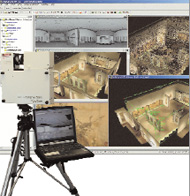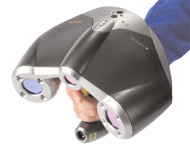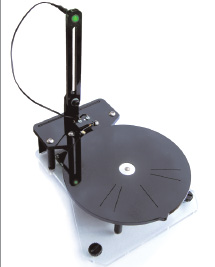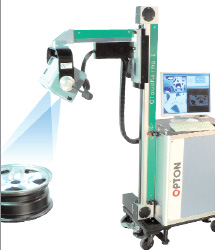Navigating Portable 3D Digitizers
Knowing your needs will help you sort through the variety of hardware options.
Latest News
March 3, 2008
By Pamela J. Waterman
 Portable, field-hardened MicroScribe systems have proven to be cost-effective alternatives totraditional equipment because of high accuracy and ease of use. (image courtesy Immersion) |
So you’ve decided to invest in a portable 3D digitizing system. More than 50 companies offer hardware in this category, and since comparing dozens of spec sheets takes time and patience, DE will get you started. We’ve compiled a sampling of today’s offerings (see table “Digitizing Hardware Vendors”) along with general tips for sorting them out. When you’re ready to dig deeper, check out the “3D Digitizing Resources” sidebar.
Begin at the End
As stressed in two previous digitizing articles in DE (“Finding Your Way to the Right Digitizer,” March 2004, p. 12, and “Low-Cost Digitizers Collect 3D Data,”January 2005, p. 32), the first consideration should be your specific project. Determine and be clear whether you are recording every detail of an ancient scarab, inspecting an airplane wing for compliance, scanning a person’s face for a medical or artistic need, recording motion or color, or documenting the piping in a nuclear facility. And do you expect this need to change with time, to handle, say, smaller or larger items?
 The Optigo from CogniTens is a portable, highperformancedimensional measurementplatform used in engineering, production, andassembly processes on the shop floor.(Image courtesy CogniTens.) |  The Metron G2 Laser Scanner with patentedoptical laser scanning technology andautomatic gain control eliminate reflectionbasedartifacts. (Image courtesy Metron Systems.) |  3rdTech’s DeltaSphere-3000 3D Laser Scannerand a screenshot of the company’sSceneVision-3D visualization software showing3D Data of the Ackland Art Museum in ChapelHill, NC. (Image courtesy 3rdTech.) |
Answers to these questions will immediately narrow your search, as many systems concentrate on a certain type of application, e.g., the human body, site surveying, small rigid parts, turbine blades, or dental impressions.
Just as important is the ultimate use for the digital data. Is generating a 3D CAD file of an object sufficient? Do you need to create a precise NURBS surface? Will you perform inspections by comparing measured data points to reference files? Are you constructing a data file for a CNC tooling path? Such goals may require different initial hardware technology capabilities that are described later.
 In Metronor’s words, this is a complete andtruly portable measurement system consistingof a dual-sensor, probing, and computersystem. (image courtesy Metronor) |  ZCorp’s handheld, self-orienting 3D scanner,the ZScanner 800, offers five times theresolution and more than double the accuracyof its first-generation 3D scanner.(image courtesy ZCorp.) |
The second major factor is the desired resolution. Do you need, for example, better than 0.002 in., or will 0.01 in. suffice? Small features may fall between measured points, so resolution (the smallest measurement a system can make) can be just as important as accuracy (how close a measurement is to the true value). The system price will vary greatly with this specification. For large parts, a related factor is tolerance stacking, when side-by-side data scans are acquired and combined; be sure to ask just how this is handled by the system.
 The TriAngles 3D Circumference Scannercaptures geometry in less than 60 secondsusing a turntable, a laser-line generator, and auser-supplied video-camera.(Image courtesy Camtronics.) |
The Technology Angle
One tactic that helps users understand the nuances among digitizing hardware is in how the equipment locates a point in space; at a very top level, systems are either camera-based or mechanically based. However, a quick look at system descriptions shows that hybrid systems abound, and within each type dozens of implementations offer their own particular benefits.
“Mechanical” vendors may state that their systems are unaffected by lighting conditions, that no surface preparations are necessary, and that postprocessing can be fast. On the other hand, “camera” manufacturers will probably tell you they can gather more data, easily measure freeform shapes, and avoid concerns about part damage. For both, ask if you can vary the resolution across a part to get fine details where necessary and save analysis time in areas with little variation.
 The Cloudforma II series of portable systems are used for onsite measurement of large andheavy objects. (Image courtesy MiiC America.) |
Locating holes and measuring angles may be fast and simple tasks for a touch-probe system, yet take longer processing times for equipment that is camera-based. Conversely, capturing the fine detail of an organic shape can be an automated process for visual systems and labor intensive with mechanically based units. However, you may find the best of both in hybrid systems such as a laser-scanner mounted on a mechanical arm. When coupled with sophisticated data-acquisition software, such hybrids successfully deal with possible limitations found with just one type or the other.
Your 3D Digitizing Needs
Learn just what the vendor means by “portable.” In a broad sense, the term refers to a hardware system that you can take to the part instead of vice versa, but does their reality match your vision and needs? Some systems fit in your hand, some combine a handheld unit with a desktop component, and others have just a desktop unit. With multi-part equipment, find out if the connections are wired or wireless; does this affect convenience, price, or both?
 The Trimble VX Spatial Station integrates stateof- the-art optical, 3D scanning, and digital imaging technology to capture the shape, detail, and precise coordinates of any job.(Image courtesy Trimble Navigation Ltd.) |
You will also discover systems that sit on a tripod, connect to a tabletop articulated arm, or roll around on a wheeled cart the size of small refrigerator. Yet, all are considered portable compared to a classic coordinate-measuring machine (CMM) mounted on a gantry over a granite-topped inspection-table.
Now dig even deeper. Does a part have to be prepped in any way? Some systems require dusting a part with powder to take off any shine. Find out if the hardware can reach or “see” all relevant details you need to capture. Ask about ease of use, point-acquisition speed, output data formats, compatibility with popular software packages, operational training requirements or options, and the terms of technical support. And when you inquire about price, consider your investment for both current and future needs. Although hardware sells for as little as $295 and upwards of $70K, there’s a lot of overlap when you examine the full cost of ownership.
Lastly, ask about the system’s robustness, weight, volume, and set-up time per use (including calibration), since all may affect day-to-day use. With all these choices, there’s sure to be a system that’s a just-right fit for your 3D digitizing needs.
3D Digitizing Resources 3D Data Capture — a DVD about 3D Digitizing from the Society of Manufacturing Engineers (SME); written by consultant Todd Grimm; sme.org. 3D SCANNING: Reverse Engineering, Inspection and Analysis — SME Conference; Disney’s Coronado Springs, Lake Buena Vista, FL USA; May 20 - May 22, 2008; sme.org. —P.M. |
Contributing Editor Pamela J. Waterman is an electrical engineer and freelance technical writer based in Arizona. You can contact her about this article via e-mail sent to [email protected].
Subscribe to our FREE magazine, FREE email newsletters or both!
Latest News
About the Author
Pamela Waterman worked as Digital Engineering’s contributing editor for two decades. Contact her via .(JavaScript must be enabled to view this email address).
Follow DE





